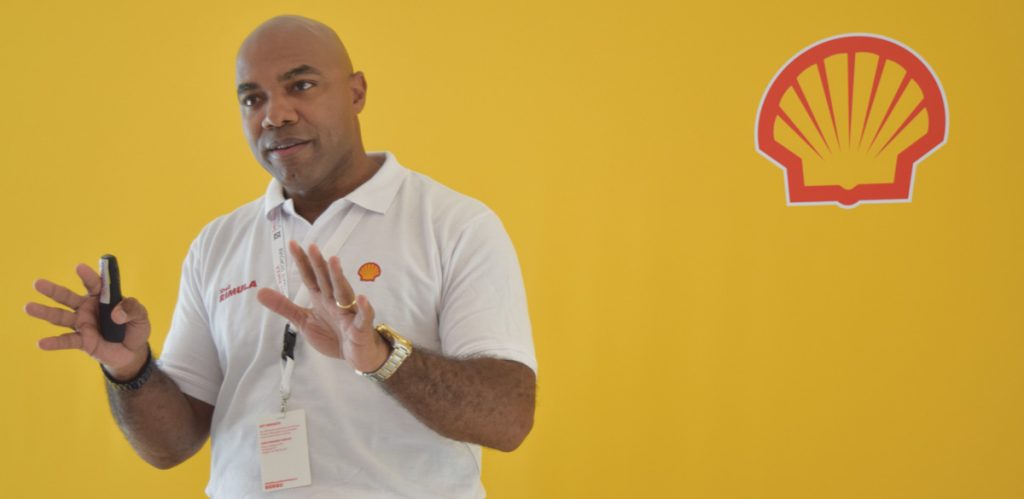Slippery path forward for oil industry

Manufacturers of engine oils are facing turbulent times, as the transport industry evolves faster than ever before. CHARLEEN CLARKE attended the Shell Rimula Ultimate Stopover in Dubai, where she discovered how this oil company is facing these challenges head on.
Most of the major oil companies have been around for a while. Shell, for instance, was established over a century ago – back in 1907. It has faced some challenges in the last 112 years, but never like those it faces now.
The reason for the current situation is the predominance of one thing in the world of wheels: change. Driven largely by environmental concerns, engine manufacturers are introducing new hardware technologies, resulting in rapidly evolving performance challenges for the lubricant industry. Whereas the diesel engine was commonplace in our industry, greener technologies – gas-powered engines and electric engines – are rising to the fore.
In Europe, truck producers are facing radical change, as legislators are insisting on a reduction in CO2 emissions from trucks by 15 percent in 2025 and 30 percent in 2030. Some say this is challenging at best and impossible at worst. “These standards are very ambitious,” notes Erik Jonnaert, secretary general of the European Automobile Manufacturers’ Association.

“This will be a major challenge for the industry and operators. What is possible for cars is often not an option for trucks – the difference between them is fundamental. Truck makers are willing to further cut carbon emissions, but this should happen at a pace that is realistic, as it will not be possible with today’s technology alone.”
Indeed, these CO2 standards will require the rapid and large-scale market uptake of alternatively powered trucks. “However, it remains highly questionable whether the required charging and refuelling infrastructure suitable for trucks can be rolled out within the span of just a few years,” Jonnaert cautions.
While the rollout of infrastructure may be questionable, one thing is certain: greener trucks are on their way. “There is no doubt that a wider choice of fuel types and improved powertrain technologies will emerge as a result of the industry’s bid to meet stricter emission targets and continue on the road to a net-zero carbon footprint, all while meeting greater consumer demand for energy,” confirms Usha Lad, senior project leader heavy-duty engine oils at Shell.
At the same time, consumer buying patterns are changing faster than ever before – and they are becoming decidedly digital. “Some 22 percent of the world’s population now shops online for everything from clothes, to electronics, furniture, food and more. And they do not want to wait at home all day for their deliveries.
“To keep their customers happy, companies have had to find solutions for rapid delivery and tighter delivery windows. As the population grows, so will on-demand deliveries and e-commerce, which will increase the number of trucks on our roads. This will further increase calls for lower emissions and greater efficiencies in the industry,” notes Lad.

It’s time to adapt or die
Both of these scenarios impact on oil companies. In this vastly changing playing field, they can adapt or die.
Rather wisely, Shell is adopting the former approach, as Jason Brown, global technology manager for diesel engine oils, notes: “We have been the world’s number one lubricant manufacturer for the last 12 years. Have we had challenges? Of course. The market has moved in unexpected ways, but we’re great at thinking out the box.”
This modus operandi bodes well in an industry that’s developing a range of alternative energies, engines and powertrain technologies to meet the growing demand for transport with lower emissions. “A global mosaic of alternative fuels and energies will co-exist as a result, based on different types of transport, journeys and local economic factors,” Lad contends.
How will that global mosaic of alternative fuels be made up? That will depend on applications – some drivetrains (pure electric vehicles, for instance) are more suited to short journeys in urban areas. Others (such as hydrogen and liquid-fuel vehicles) are better suited to journeys between cities.
Hydrogen to the fore
Going forward, hydrogen and electric propulsion are likely to find favour with light-duty truck operators.
Hydrogen has the characteristics to be a desirable component of the energy transition. “It is clean, low carbon (when produced from renewable sources) and flexible. Current technologies can already produce, supply, store and use hydrogen in many applications, but increased scale in material use and improvements in energy efficiency are needed,” says Lad.
Its potential has even been noticed by the United States (US) Army – General Motors and the US Army’s Tank Automotive Research, Development and Engineering Centre have built a hydrogen bakkie (or pickup truck, as they call it). It’s low carbon, quick to refuel, quieter to run and produces 7,5 litres of water per hour, which could be useful in hostile deserts.
Electric vehicles grow in popularity
Electric vehicles are also becoming popular – and this is a trend that has been addressed by Shell. “For example, we recently bought NewMotion, one of Europe’s largest electric vehicle charging providers, and signed an agreement with IONITY, a joint venture that was established to build a network of charging points with a payload of 350 kW along main European motorways,” reveals Lad.
Heavy-duty trucks, on the other hand, are expected to remain reliant on liquid fuels in the long term, given the energy density needed from a fuel. “While diesel remains the primary fuel for heavy-duty trucks, we are working to squeeze the most out of each drop, by providing high-quality lubricants that have been developed in collaboration with our industry partners. Low-viscosity lubricants and other hardware efficiencies can play a key role in helping fleets to run more efficiently and lower their total cost of ownership,” Lad points out.

Biofuels continue to be popular
Biofuels will continue to be important in the longer term, the Shell team believes. Just one example is McDonald’s India, which has initiated a project to help reduce its carbon footprint. McDonald’s recycles the used cooking oil from its kitchens into biodiesel, which is used to fuel more than half of its delivery trucks. “For our part, Shell is involved in a joint venture called Raízen with Brazilian company Cosan, which is the world’s largest producer of sugar-cane ethanol,” says Lad.
GTL has merit
Shell gas-to-liquid (GTL) fuel is another type of alternative fuel for use in existing diesel engines without modifications, which can lower local emissions with no infrastructure investment required.
Shell recently conducted an intensive nine-month trial in the United Kingdom (UK) with 50 DAF New LF 230 reefers fuelled with Shell GTL Fuel. This has delivered significant air-quality improvements, including a 47-percent reduction in NOx emissions.
Shell GTL fuel is also already in daily use within commercial fleets in Germany and the Netherlands.
LNG weighs in on price
Meanwhile, liquefied natural gas (LNG) is emerging as a cost-competitive cleaner fuel to power heavy-duty transport.
LNG offers advantages such as higher energy density and – if used in dedicated applications, such as corridors – easier distribution. This means only a limited number of retail stations (in the highway networks in particular) would be required to supply heavy-duty vehicle fleets with sufficient LNG fuel.
In the (very) long run, LNG could be supplemented either with gas from biomass, or power-to-gas (PtG) fuels. This can be achieved by directly using biogas/PtG or using LNG from the natural-gas grid into which biogas or some syngas has been fed previously.
How is this shaping the future of lubricant technologies?
The path to lower viscosity
As fuel economy targets and the associated penalties become increasingly important for manufacturers globally, engine oil has a role to play as a critical enabling technology. So, how can lubricants help truck drivers and fleets to achieve better fuel economy?
It’s all about viscosity. The lower the engine oil viscosity, the quicker it flows to where it’s needed in the engine, generating less friction than oils of higher viscosity, so the engine operates more efficiently and produces less CO2 emissions. Accordingly, a global move towards lower-viscosity engine oils is on the cards.
“North American and European original equipment manufacturers (OEMs) have transitioned from 15W-40/10W-40 to thinner oils such as 10W-30/5W-30 to realise fuel economy savings. Over the next three to five years the trend will move towards 5W-20/0W-20 viscosity oils. The entire industry is taking steps to move towards lower-viscosity engine oils, with OEMs designing suitable engines and industry regulators standardising them,” says Brown.
What does this mean for a lubricant manufacturer? “We need to ensure there is a standardised practice to demonstrate the performance of engine oils. One of the ways in which we achieve this is via field trials,” he explains.
Typically, companies run trials using one specific type of truck. “However, in our quest to provide credible fuel economy numbers, we decided back in 2015 to take a statistically modelled chance. We picked six different European trucks (all with decent service histories) and six engine manufacturers and ran a fuel-economy trial using this cross spectrum of vehicles and engines,”
Not only did the company test its products in six different trucks and using six different engines, it also tested in different applications. “We ran tests pertaining to the highway cycle, depot-to-depot cycle and also the depot-to-inner-city cycle,” he explains.
Of course, these tests were specific to Europe. The Shell team decided that this was simply not comprehensive enough. “So, in 2016, we repeated the process in China. Then, we followed up with an identical test in the US with the top six diesel-engine manufacturers there,” he tells FOCUS.
This was an industry first. “It was one of a kind. No one else has done this before and I don’t believe any other company would have the guts to do it. It is also a very expensive exercise,” Brown points out.
The data that was gathered is fascinating. “Europe and the US produced similar results. China differed – which makes sense because they’re on Euro 4,” he comments.
Academic research ongoing
While field trials are vital to the future success of any lubricant manufacturer, going forward, ongoing academic research will also be required. “Besides conducting our own research and development, we also sponsor research in lubricant wear in engines, including a Shell-sponsored PhD project at Imperial College London, UK. It aims to further the understanding of the mechanisms behind soot-induced engine wear while using a range of state-of-the-art experimental techniques,” explains Lad.
Shell is a member of the Lubrication Consortium, which focuses on lubrication of the piston assembly. “In this consortium, we are the only lubricant company. Other members include a number of important OEMs with which Shell does business. One output of this project is software that can be used to predict friction and wear in piston assemblies (for both light-duty and heavy-duty engines),” Lad tells FOCUS.
Shell is also active at Tsinghua University, in Beijing, China, where its work focuses primarily on electric vehicles, but also includes research into the lubricant sensitivities of vehicles containing petrol particulate filters.

Collaboration is key
While the future path will be peppered with ever-increasing technological developments, field trials and engagements with academic institutions, collaboration with customers and even competitors will also be key to survival. “Greater collaboration will need to be seen throughout the entire fleet industry to achieve the next generation of fleet efficiency,” notes Lad.
In fact, many Shell senior executives insist that collaboration will be key to the success of the company and, indeed, the industry.
Dan Arcy, global OEM technical manager at Shell, is one such person. “We have close relationships with many OEMs, and we work together on numerous engineering projects. We keep most of these projects very confidential, as you can probably understand.
“We like to be at the forefront of technology – so we need to have relationships with many if not all of the OEMs in order to understand their needs. This is essential to ensure we are delivering high-quality lubricants that cater to new fuel and vehicle technologies,” he comments.
Lad points to more of the same in the future. “When working towards more efficient, cleaner fuel, vehicle and lubricant options for future freight and transport, collaboration will be key for success. Bearing in
mind the road ahead for transport, I believe that we will see unprecedented collaboration from across the fleet and transport sectors – from those involved in the research that dictates changing policies, to those involved in the design and manufacture of new vehicle technologies.
“Building on this foundation, we’ll then start to see industry collaboration taken to the next level, with the aggregation of a range of fleet services,” she believes.
We’re beginning to see key industry players taking the lead with the formation of strategic partnerships to enhance their offerings and expertise. We’ve already seen this among OEMs – as the likes of Traton and Hino work together to tackle the many challenges brought by e-mobility. Maybe this will happen among lubricant manufacturers, too.
Shell has already joined forces with Total. “We have hydrogen stations across Germany, Los Angeles, California and the UK. Together with Air Liquide, Daimler, Linde, OMV and Total, we are partnering H2 Mobility in Germany, which aims to build a hydrogen refuelling network of 400 filling stations by 2023,” Lad reveals.
Last year, Petronas and Shell announced that they would be working together – they’re partners in LNG Canada, a joint venture among Shell, Petronas, PetroChina, Mitsubishi and Kogas. LNG Canada is expected to export 26-million tonnes of LNG to emerging Asian markets each year.
Shell, which has a 40-percent working interest in the project, is banking on global demand for LNG to double by 2035, much of it driven by Asian markets where natural gas is expected to replace coal use.
As manufacturers of engine oils face increasingly turbulent times, will we see other forms of collaboration? You can bet your bottom drop of oil on it.
Published by
Charleen Clarke
focusmagsa




